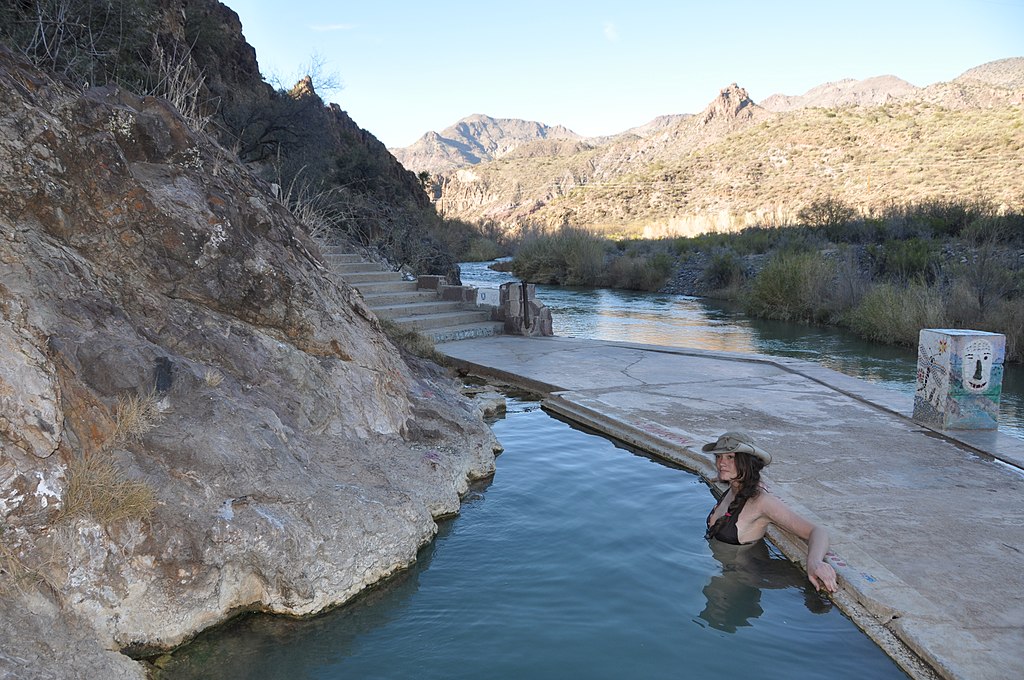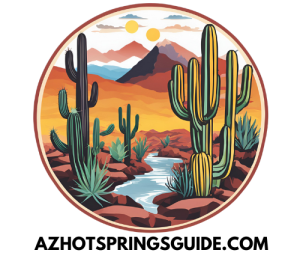
Greg Walters from Eaton, United States, CC BY 2.0, via Wikimedia CommonsDiscover all of the hot springs in Arizona, showcased on this site, featuring an interactive state map, regional listings, and a unique guide to hot springs near Phoenix and Sedona. Each natural spring listing includes detailed descriptions, seasonal access information, driving directions, high-quality photos, visitor videos, precise GPS coordinates, and detailed trail maps.
Arizona’s remarkable desert landscape cradles dozens of therapeutic natural hot springs, drawing both adventure seekers and wellness enthusiasts. These geothermal wonders are scattered throughout diverse terrains, from the Sonoran Desert’s saguaro-studded vistas to the dramatic cliffs of the Mojave Desert near Lake Mead, and the pristine wilderness of the Tonto National Forest.
The Grand Canyon State offers various types of hot springs experiences, from developed sites like Castle Hot Springs with their luxury amenities and historic bathhouses, to secluded natural pools along the Colorado River that require challenging hikes to access. While many springs are located on Bureau of Land Management (BLM) land and National Forest areas, some are situated on private ranches or Native American reservations, requiring permits or guided access.
What Makes Arizona’s Hot Springs Hot?
The natural hot springs that dot Arizona’s dramatic landscape aren’t just happy accidents – they’re the result of fascinating geological processes beneath the Earth’s surface. Deep underground, groundwater seeps through cracks and fissures in the rock, where it encounters intensely heated rocks. This geothermal heating process can occur both in volcanic areas, where ancient magma chambers still radiate heat, and in non-volcanic zones through what geologists call the Geothermal Gradient – the natural increase in rock temperature as depth increases.
In Arizona’s case, most hot springs emerge through a complex network of fault lines that crisscross the state’s geology. As the heated water rises back toward the surface through these natural pathways, it often dissolves minerals from surrounding rock formations. This explains why many of Arizona’s hot springs have distinctive mineral contents and therapeutic properties that have drawn visitors for centuries, from indigenous peoples to modern-day wellness seekers.
The temperature of Arizona’s hot springs can vary dramatically based on their specific geological setting. Some springs emerge at a pleasant bathing temperature, while others can reach dangerously high temperatures that require cooling before they’re safe for soaking. The Verde Hot Springs, for example, typically maintain a comfortable temperature around 98-104°F (37-40°C), making them perfect for relaxation, while other springs in more geologically active areas can exceed 120°F (49°C).
Understanding these natural heating processes helps visitors appreciate just how special these geothermal features are – they’re literally windows into the Earth’s inner workings, offering unique experiences that connect people with Arizona’s ancient geological history.
Protect Our Desert Waters – No Personal Care Products Allowed!

Arizona’s natural hot springs are delicate desert ecosystems, not commercial bathing facilities. They lack the filtration and water treatment systems found in developed resorts. Using any soaps, shampoos, or personal care products – even those labeled “biodegradable” or “natural” – can harm these sensitive desert environments. These products don’t fully decompose and can:
- Contaminate precious desert water sources
- Harm native desert wildlife and fish species, particularly in riparian areas
- Disrupt the natural mineral balance of the springs
- Pollute downstream water systems, including the Colorado River and its tributaries
Using these products in hot springs on Bureau of Land Management (BLM) land, National Forest areas, or other public lands is prohibited by law. Violations can result in significant fines. To report violations that may harm Arizona’s natural hot springs, contact the local BLM office or Forest Service rangers. Photo documentation can help authorities address repeated violations.
Help preserve these unique geothermal treasures for future generations by practicing Leave No Trace principles and respecting posted guidelines at each spring location.
Preserve The Land – Leave No Trace
The fragile desert ecosystems surrounding Arizona’s natural hot springs require special care and respect. These rare geothermal oases have been sacred to indigenous peoples for thousands of years and remain irreplaceable natural treasures. In our harsh desert environment, these springs are especially vulnerable to human impact, so pack out everything you bring – including trash, food scraps, and clothing items. If you encounter litter from previous visitors, help protect these precious waters by carrying it out. Many of Arizona’s hot springs are remote and lack regular maintenance, and each visitor’s commitment to preservation ensures these therapeutic waters remain pristine for future generations.
Arizona Hot Springs Map
Here’s a quick map of all the hot springs you can visit, both on public land, as well as commercial hot springs.
Arizona Hot Springs Guide is built and maintained by outdoor enthusiasts in Arizona. We do our best to keep the site as up to date as possible.
